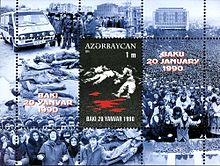Black January
As Black January the violent crackdown is Azerbaijani independence movement and the pogroms against the Armenians in Baku from 19 to 20 January 1990 from troops of the Soviet Union called. The event resulted in the deaths of over a hundred civilians, mostly Azerbaijanis , while around 90 Armenians had been killed in the previous pogrom.
In a resolution of January 22, 1990, the Supreme Soviet of the Azerbaijani SSR stated that the decree of the Presidium of the Supreme Soviet of January 19, imposing a state of emergency over Baku and placing it under military control, is considered an aggressive act. Black January is seen as the rebirth of the Republic of Azerbaijan and is one of the events during the glasnost and perestroika era, when the Soviet Union used violence against dissenters but also protected national minorities.
Events
prehistory
On January 9, 1990, the Supreme Soviet of the Armenian SSR voted to include Nagorno-Karabakh in its state budget and allowed the population to take part in Armenian elections. This represented a disregard for Soviet rule and Azerbaijani jurisprudence and caused anger across Azerbaijan. This was followed by demonstrations by the Azerbaijani Popular Front Party demanding that Azerbaijani communist functionaries be ousted and independence from the Soviet Union . The party's rhetoric was strongly anti-Armenian . On January 12, the Popular Front Party of Azerbaijan organized a national defense committee with branches in factories and offices in Baku to mobilize people to fight the Armenian people .
Local Azerbaijani authorities were unable to act and restore order due to internal disputes. In addition, the Azerbaijani authorities ordered the 12,000 soldiers from the Interior Ministry not to intervene in the riot in Baku. Numerous units of the Soviet Army and naval units of the Baku Garrison and Caspian Flotilla did not intervene to stop the outbreak of violence and claimed not to have received any order from the Moscow authorities. From January 13, massive anti-Armenian pogroms took place, resulting in the deaths of 90 Armenians . Thousands more fled Baku or were evacuated by the Soviet Army.
state of emergency
On January 15, the authorities declared a state of emergency in other parts of Azerbaijan, but not in Baku. The pogroms against the Armenian population began to subside. Fearing that the central Soviet authorities would intervene, the Popular Front Party of Azerbaijan, which had already taken control of numerous Azerbaijani regions, began to blockade military barracks.
After the central television station was destroyed and the Soviet special forces cut the telephone and radio connections, 26,000 soldiers from the Soviet Army , the Internal Forces and the Navy marched into Baku on the late evening of January 19, 1990 and broke through the barricades to stop the unrest Defeat Armenians and the Azerbaijani Popular Front.
Following the bloody suppression of the uprising, Mikhail Gorbachev declared in a 12-minute appearance on Soviet television that he regretted the dead and that there was no other way out than to use the military: “The events in Baku have taken a particularly tragic turn. There were more and more calls for seizure of power by force. "Gorbachev's greatest domestic political opponent and later President of Russia Boris Yeltsin condemned his decision:" It is a mistake to send troops and suppress ethnic disputes by using force. "
Number of victims
According to a report, 93 Azerbaijanis and 29 Soviet soldiers were killed in street fighting on January 19. According to other reports, 21 soldiers were killed and 90 wounded in the fighting. However, how the soldiers died is still controversial. According to the Soviet authorities, the number of victims on the part of the soldiers can be traced back to the armed resistance, although the soldiers' deaths may also have been caused by self-fire.
See also
- Pogrom in Baku (1990)
Web links
- The research project "Black January" - History and Memory , accessed on June 9, 2012
- Moskauer Deutsche Zeitung of February 3, 2005, accessed on June 9, 2012
swell
- ↑ a b Michael P. Croissant: The Armenia-Azerbaijan Conflict: causes and implications. , Greenwood Publishing Group, 1998, pp. 36, 37
- ↑ a b Human Rights Watch. Playing the "Communal Card": Communal Violence and Human Rights
- ^ A b Bill Keller : UPHEAVAL IN THE EAST: SOVIET UNION; Force as a Last Resort: Armed Power Salvages Moscow's Facing Authority . The New York Times . January 29, 1990. Retrieved October 30, 2012.
- ↑ Mikhail Gorbachev : On My Country and the World , p. 96
- ^ Anita Inder Singh: Democracy, Ethnic Diversity, and Security in Post-Communist Europe . Greenwood Publishing Group, 2001. p. 61
- ^ A b Thomas de Waal: Black Garden: Armenia and Azerbaijan through Peace and War . New York University Press. 2003. pp. 90-93
- ^ A b Richard G. Hovannisian: Remembrance and Denial: The Case of the Armenian Genocide . Wayne State University Press. 1999. p. 195
- ↑ 1990: Gorbachev explains crackdown in Azerbaijan . 1990 ( bbc.co.uk [accessed January 29, 2018]).
- ^ Mark R. Beissinger: Nationalist Mobilization and the Collapse of the Soviet State . Cambridge University Press. 2002, p. 377

